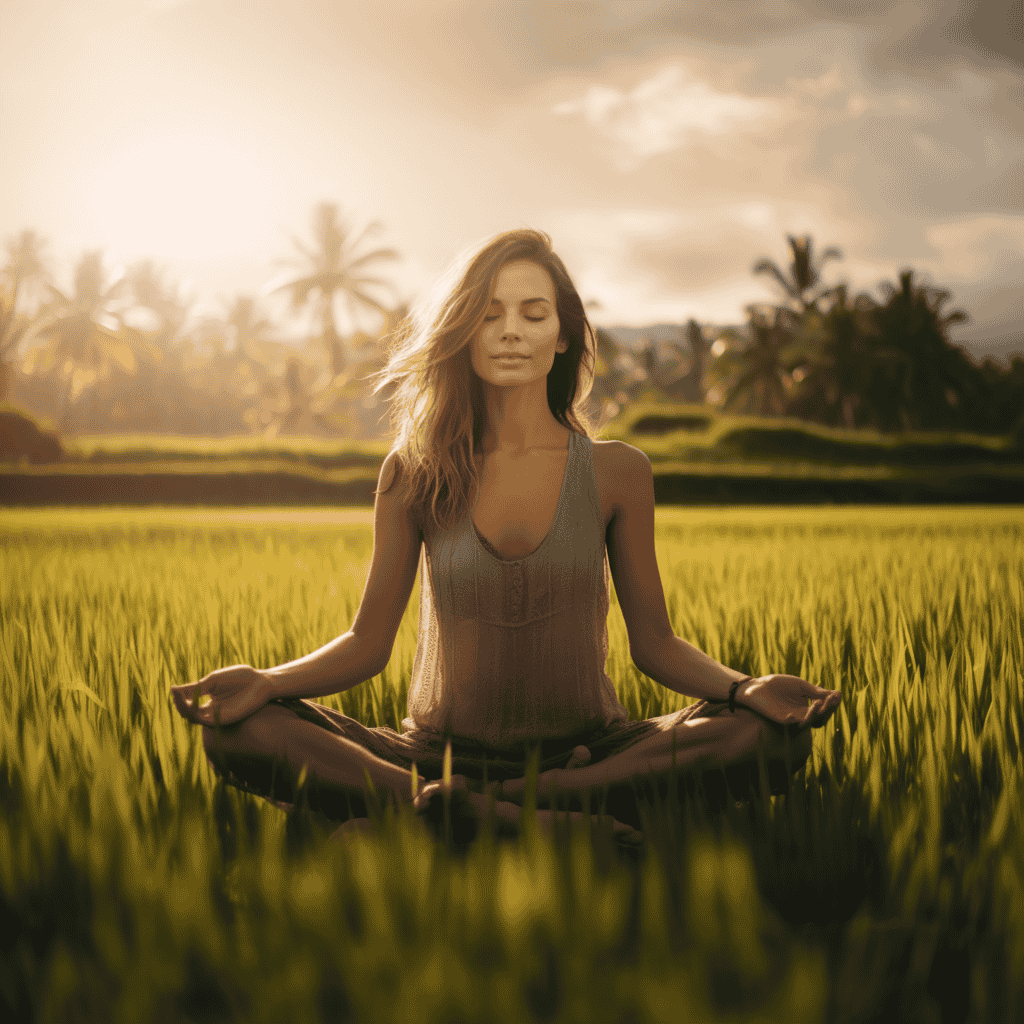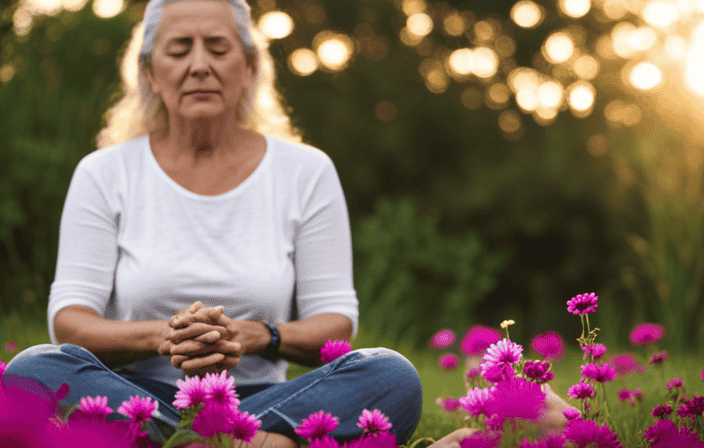Meditation
The Elemental Energies: Earth, Water, Fire, Air, And Ether

Coincidence is a fascinating phenomenon that reminds us of the interconnectedness of the world.
It is no coincidence that the ancient philosophers recognized the elemental energies of earth, water, fire, air, and ether as the building blocks of existence. These elements hold immense power and wisdom, and by tapping into their energies, we can unlock a deeper understanding of ourselves and the world around us.
In this article, we will explore the symbolism, meanings, and practical applications of these elemental energies, offering a path towards balance, healing, and manifestation in our lives.
Key Takeaways
- The Five Elements consist of Earth, Water, Fire, Air, and Ether, each with their unique energy and qualities.
- Personalized practices and support are offered to harness the healing and manifestation powers of the elemental energies.
- Deepening understanding and expanding spiritual awareness can lead to a greater sense of balance and harmony in life.
- Each element, including Earth, Water, Fire, Air, and Ether, has its own specific attributes and benefits for personal growth and transformation.
The Five Elements
I love exploring the unique energy and healing properties of the five elements: earth, water, fire, air, and ether.
Each element has its own distinct qualities that contribute to our overall well-being and spiritual growth.
Earth represents stability and nourishment, grounding us and connecting us to the natural world.
Water is the element of emotion and intuition, purifying and balancing our emotions, and allowing us to flow with life’s changes.
Fire ignites our passion and creativity, empowering us to manifest our dreams and desires.
Air brings clarity and insight, enhancing communication and opening up new opportunities.
And ether connects us to the divine, expanding our consciousness and bringing peace and tranquility.
Balancing these elemental energies brings harmony and a deeper sense of connection to ourselves and the world around us.
Symbolism and Meanings
Symbolism and meanings of the five elements can be explored through ancient philosophy, meditation, energy work, rituals, ceremonies, symbolism, astrology, tarot, and seeking guidance from experienced practitioners.
-
Earth: It symbolizes stability, security, and physical abundance. By connecting with the earth, we tap into its energy, which enhances wealth, health, and a sense of belonging. It brings grounding, stability, and a deeper connection to the natural world.
-
Water: This element represents emotion and intuition. It cleanses and purifies our emotions, allowing us to flow with life’s changes. Water enhances our insights, adaptability, and fluidity, opening us up to new opportunities.
-
Fire: A symbol of power and passion, fire ignites transformation and creativity. It helps us manifest our dreams and desires, increasing our drive and ambition to explore new possibilities.
-
Air: The element of communication and knowledge, air symbolizes clarity and insight. It clears our minds and opens up opportunities for meaningful conversations and exchanges. It also allows us to access our inner wisdom.
-
Ether: Representing spirit and our connection to the divine, ether expands our consciousness and brings peace and tranquility. It helps us see life from a wider perspective and access our highest potentials.
By understanding the deeper meanings of these elements, we can bring harmony and well-being into our lives.
Balancing Energy
Balancing the energy of the five elements brings harmony and well-being into my life.
As I connect with the earth element, I feel a sense of stability and security. It grounds me and helps me connect with the natural world around me.
The water element cleanses and purifies my emotions, allowing me to flow with ease and adapt to new opportunities.
Fire ignites my passion and creativity, empowering me to manifest my dreams and desires.
The air element brings clarity and insight, helping me access my inner wisdom and engage in meaningful conversations.
And finally, the ether element connects me to the divine and expands my consciousness, bringing peace and tranquility.
By balancing these elements within myself, I am able to experience a deep sense of harmony and well-being in all aspects of my life.
Practical Applications
Practicing meditation and energy work helps me harness the unique qualities of the five elements for healing and manifestation. In my journey, I have discovered practical applications that have brought harmony and well-being into my life.
Here are five ways I incorporate the elemental energies:
-
Rituals: I create sacred ceremonies that honor each element, using symbols, candles, and natural objects to connect with their energy.
-
Tarot: I use tarot cards as a tool to tap into the elemental energies and gain insights and guidance.
-
Astrology: I explore my birth chart to understand how the elements influence my personality and life path.
-
Symbolism: I surround myself with objects and images that represent the elements, reminding me of their power and presence.
-
Seeking Guidance: I consult experienced practitioners who can offer wisdom and guidance on how to work with the elemental energies.
By embracing these practical applications, I have deepened my connection to the elements and experienced profound transformation and growth in my life.
Healing and Manifestation
Healing and manifestation have been transformative in my life as I tap into the unique qualities of the five elements through meditation and energy work.
Each element holds a specific energy that contributes to my overall well-being and helps me manifest my desires.
When I connect with the Earth element, I feel grounded, stable, and deeply connected to the natural world.
Water brings a sense of emotional balance and intuition, allowing me to flow with life’s challenges.
Fire ignites my passion and creativity, fueling my dreams and bringing new possibilities.
Air clears my mind, enhances communication, and provides access to inner wisdom.
And Ether connects me to the divine, expanding my consciousness and bringing peace.
By balancing these elements, I find harmony and the ability to manifest my highest potentials.
Meditation and Energy Work
When I engage in meditation and energy work, I experience a deep sense of calm and connection to the natural world. It is a practice that allows me to tap into the elemental energies of earth, water, fire, air, and ether, bringing harmony and balance to my being.
During my meditation sessions, I focus on each element and visualize their unique qualities and energy flowing through me. This process helps me to ground myself in the stability and nourishment of the earth, cleanse and purify my emotions with the fluidity of water, ignite my passion and creativity with the power of fire, gain clarity and insight through the wisdom of air, and connect to the divine and expand my consciousness with the ethereal energy of ether.
Through this practice, I am able to enhance my overall well-being and manifest my desires with a sense of peace and tranquility.
Rituals and Ceremonies
During rituals and ceremonies, I connect deeply with the natural world and tap into the transformative power of the five elements. It is a sacred time where I honor and work with the energies of earth, water, fire, air, and ether. Each element brings its own unique energy and symbolism, and I use them in my rituals to bring balance and harmony into my life.
In my ceremonies, I create a sacred space and use specific rituals to invoke the energy of each element. I might light a candle to represent fire, pour water into a bowl to symbolize water, burn sage to cleanse the air, or place crystals on the ground to connect with the earth. These rituals help me to deepen my connection with the elements and allow their energy to flow through me.
Through these rituals and ceremonies, I am able to align myself with the natural world and the energies of the elements. I feel a sense of peace and tranquility as I tap into the transformative power they offer. It is a time of reflection, healing, and manifestation, where I can access my inner wisdom and connect with the divine. By honoring and working with the elemental energies, I am able to bring more balance and harmony into my life.
| Element | Symbolism | Energy |
|---|---|---|
| Earth | Stability, security, physical abundance | Grounding, wealth, health |
| Water | Emotion, intuition | Cleansing, balance, adaptability |
| Fire | Power, passion, transformation | Manifestation, drive, ambition |
| Air | Communication, knowledge | Clarity, insight, opportunities |
| Ether | Spirit, connection to the divine | Expansion, higher consciousness, peace |
Seeking Guidance
Seeking guidance from experienced practitioners is an important aspect of my spiritual journey in working with the transformative power of the five elements. These practitioners have a deep understanding of the energies and can offer valuable insights and techniques to enhance my connection with the elemental forces.
Sharing Wisdom: Experienced practitioners can provide valuable knowledge and wisdom about working with the five elements. They can guide me on how to tap into the unique energy of each element and harness its healing and manifestation powers.
Personalized Practices: These practitioners can help me tailor my spiritual practices to align with the specific element that I need to focus on at any given time. They can offer personalized rituals, meditations, and ceremonies to deepen my connection with the elemental energies.
Support and Encouragement: Seeking guidance from experienced practitioners provides me with a supportive and nurturing environment. They can offer encouragement, reassurance, and help me navigate any challenges or obstacles that may arise on my spiritual journey.
Through seeking guidance, I am able to deepen my understanding of the elemental energies, expand my spiritual awareness, and experience a greater sense of balance and harmony in my life.
Frequently Asked Questions
How can the five elements be used in astrology and tarot readings?
In astrology and tarot readings, the five elements can be used to gain insight and guidance. Each element represents different aspects of life and can help us understand ourselves and our experiences on a deeper level.
Are there any specific rituals or ceremonies associated with each of the five elements?
Each of the five elements has its own rituals and ceremonies. For example, to connect with the earth element, I like to practice grounding exercises and create an altar with stones and plants.
What are some common symbols that represent each of the five elements?
Some common symbols that represent each of the five elements are: Earth – a tree or a mountain; Water – a wave or a river; Fire – a flame or a sun; Air – a feather or a breeze; Ether – a star or a lotus flower.
How can the five elements be incorporated into daily life for improved well-being?
Incorporating the five elements into daily life enhances well-being. By connecting with the stability of earth, the flow of water, the passion of fire, the clarity of air, and the spirituality of ether, I find balance and harmony.
Are there any specific crystals or gemstones associated with each of the five elements?
Yes, there are specific crystals or gemstones associated with each of the five elements. For Earth, I would recommend using stones such as Jasper or Hematite. For Water, Moonstone or Aquamarine can be beneficial. Fire can be enhanced with Carnelian or Citrine. Air can be supported with Clear Quartz or Selenite. Finally, for Ether, Amethyst or Celestite can help connect to the spiritual realm. Incorporating these stones into daily life can amplify the energy of each element and promote well-being.
Meet Kiran, the guiding light of wisdom behind the empowering content at OurMindAndBody.com. As a talented and compassionate writer, Kiran weaves words with grace and insight, sharing profound knowledge and practical advice to inspire positive transformations in the lives of readers.
With a background in psychology and a deep-rooted passion for well-being, Kiran brings a unique blend of expertise and empathy to her writing. Her journey into the realm of mindfulness, meditation, and yoga began as a personal quest for self-discovery and healing. Having experienced the profound benefits of these practices firsthand, Kiran is committed to empowering others to embark on their own journeys of self-exploration and growth.
Meditation
The Power Of Meditation: Cultivating Inner Peace And Self-Awareness

Similar to a calming breeze that comforts the spirit, meditation possesses the ability to foster internal peace and self-understanding. In a society inundated with ongoing diversions and commotion, this purposeful routine enables us to look within ourselves, calming the mind and nurturing the soul.
Through mindfulness, concentration, and self-reflection, meditation offers a path to mental clarity, emotional well-being, and spiritual growth.
Join me on a journey to explore the various types and techniques of meditation, as we discover the profound benefits it brings to our lives.
Key Takeaways
- Meditation is an intentional act of directing attention inward, cultivating mental clarity, emotional well-being, and spiritual growth.
- The purpose of meditation is to focus the mind, achieve heightened awareness and inner stillness, and promote peace, balance, and self-discovery.
- There are various types and techniques of meditation, including concentrative meditation, mindfulness meditation, and loving-kindness meditation.
- Regular meditation practice can reduce anxiety and depression, improve focus and attention, enhance emotional resilience, boost creativity and problem-solving skills, and strengthen the immune system.
What is it?
I can explain what meditation is based on my pre-existing knowledge.
Meditation is an intentional act of directing attention inward. It involves techniques for mindfulness, concentration, and self-awareness.
The purpose of meditation is to focus the mind and achieve heightened awareness and inner stillness. It cultivates mental clarity, emotional well-being, and spiritual growth.
The benefits of regular meditation practice are numerous. It reduces stress, improves mental clarity, and promotes emotional well-being. It also fosters spiritual growth, cultivates peace, balance, and self-discovery, and enhances overall well-being and sense of purpose.
Different types and techniques of meditation cater to individual preferences. Whether it’s concentrative meditation, mindfulness meditation, or loving-kindness meditation, there is something for everyone.
Regular practice is key for reaping the benefits of meditation. So, start your meditation journey today in a quiet space and experience the power of cultivating inner peace and self-awareness.
Definition and Origin
Derived from the Latin word ‘meditatio’, the term ‘meditation’ involves deep contemplation and introspection. Its origins cannot be attributed to a single individual. Meditation is a practice that has evolved over time, with various cultures and traditions adopting their own techniques and approaches.
It is a timeless practice that has been embraced by many for its profound benefits. Here are three key aspects to consider when exploring the definition and origin of meditation:
-
Historical Significance: Meditation has been practiced for thousands of years, with evidence of its existence in ancient civilizations such as Egypt, India, and China.
-
Spiritual Connection: Meditation has long been associated with spiritual traditions, serving as a means to connect with one’s inner self, higher consciousness, or the divine.
-
Evolution of Techniques: Throughout history, different meditation techniques and styles have emerged, each emphasizing different aspects such as mindfulness, concentration, or loving-kindness.
Understanding the rich history and diverse origins of meditation can deepen our appreciation for its transformative power in cultivating inner peace and self-awareness.
Purpose and Benefits
The purpose of engaging in meditation is to achieve a state of heightened awareness and inner stillness. This ultimately leads to reduced stress, improved mental clarity, and enhanced emotional well-being.
Through the intentional act of directing my attention inward, I am able to cultivate peace, balance, and self-discovery. By focusing my mind and practicing mindfulness, I transform my relationship with my mind and the world around me.
This practice not only improves my overall well-being and sense of purpose, but it also strengthens my emotional resilience and boosts my creativity and problem-solving skills.
Regular meditation practice is like a gentle exercise for my mind. It allows me to reduce anxiety and depression, improve my focus and attention, and strengthen my immune system.
It is through this practice that I am able to cultivate inner peace and self-awareness, leading to a more fulfilling and meaningful life.
Introduction to Meditation
Learning about the different meditation styles and understanding their benefits is an important first step in my meditation journey. It’s fascinating to explore the various techniques and discover which ones resonate with me the most.
The first technique I’m interested in is concentrative meditation, where I focus my attention on a single object, such as my breath or a mantra. This helps me develop concentration and inner stillness.
The second technique is mindfulness meditation, which involves observing my thoughts and feelings without judgment. This practice enhances my self-awareness and cultivates a sense of presence in the present moment.
Lastly, I’m intrigued by guided meditation, where I listen to a recorded voice guiding me through visualization or relaxation exercises. This technique helps me relax deeply and connect with my inner self.
By exploring these different meditation styles, I can lay a strong foundation for my practice and begin my journey towards cultivating inner peace and self-awareness.
Types and Techniques
I’m intrigued by the different types and techniques of meditation and how they can enhance my practice. Each type offers a unique approach to cultivating inner peace and self-awareness.
Concentrative meditation involves focusing on a single point, such as the breath or a mantra, to quiet the mind and increase concentration.
Mindfulness meditation encourages non-judgmental awareness of the present moment, allowing thoughts and sensations to come and go without attachment.
Loving-kindness meditation promotes feelings of compassion and empathy towards oneself and others.
Transcendental meditation uses a specific mantra to achieve a state of deep relaxation and expanded awareness.
Guided meditation involves following the guidance of a teacher or audio recording.
Techniques like focusing on the breath, visualization, mantras, body scans, and walking meditation can also enhance the meditation experience.
Exploring these types and techniques can deepen my understanding and practice of meditation.
Benefits of Regular Practice
Now that we have explored the different types and techniques of meditation, let us delve into the remarkable benefits that regular meditation practice can bring into our lives. Through consistent effort and dedication, meditation has the power to transform our overall well-being and sense of purpose. It is not just about finding inner peace and self-awareness, but also about improving our mental and emotional resilience, boosting our creativity and problem-solving skills, and even strengthening our immune system.
To emphasize the benefits of regular meditation practice, let’s take a moment to reflect on a table that highlights some of the positive impacts it can have on our lives:
| Benefits of Regular Meditation Practice | ||
|---|---|---|
| Reduces anxiety and depression | Improves focus and attention | Enhances emotional resilience |
| Boosts creativity and problem-solving skills | Strengthens immune system |
By incorporating meditation into our daily lives, we can experience these incredible benefits and cultivate a greater sense of inner peace, clarity, and self-awareness.
Tips for Success
Practicing regularly and finding a quiet and comfortable space are important tips for a successful meditation practice. Consistency is key; setting aside dedicated time for meditation allows for a deeper connection with oneself.
As I have discovered on my meditation journey, there are a few emotional benefits that can be experienced through regular practice:
- Inner peace: Meditation helps quiet the mind, creating a space for inner stillness and tranquility.
- Self-awareness: By observing our thoughts and emotions without judgment, we gain a deeper understanding of ourselves and our reactions.
- Emotional balance: Through regular meditation, we develop the ability to regulate our emotions, cultivating a sense of calmness and resilience.
- Enhanced focus: Meditation improves our ability to concentrate, allowing us to be more present and attentive in our daily lives.
By incorporating these tips and embracing a regular meditation practice, we can harness the power of this ancient technique to cultivate inner peace and self-awareness.
Quiet and Comfortable Space
Finding a tranquil and cozy environment is crucial for creating an optimal meditation space. It is important to have a dedicated space where you can feel relaxed and at ease.
Look for a quiet corner in your home or find a serene outdoor spot where you can connect with nature. Make sure the space is clean and free from distractions.
Soft lighting and comfortable cushions or a meditation mat can enhance your experience. Creating a peaceful ambiance with calming scents or gentle music can also help set the mood.
Remember, the goal is to create a space that promotes relaxation and allows you to focus inward. By finding a quiet and comfortable space, you can truly immerse yourself in the practice of meditation and cultivate inner peace and self-awareness.
Dedicated Time for Meditation
I prioritize setting aside dedicated time for my daily meditation practice. It is important to create a space in my schedule where I can fully immerse myself in the practice without any distractions. By allocating specific time for meditation, I am able to make it a priority and ensure that it becomes a consistent part of my daily routine.
To keep myself accountable and organized, I have created a simple table to plan and track my meditation sessions:
| Day | Time | Duration |
|---|---|---|
| Monday | 7:00 AM | 15 minutes |
| Tuesday | 8:30 PM | 20 minutes |
| Wednesday | 6:00 AM | 10 minutes |
| Thursday | 12:00 PM | 15 minutes |
| Friday | 5:30 PM | 25 minutes |
Having a dedicated time for meditation allows me to fully commit to the practice and reap its benefits. It helps me create a sense of discipline and consistency, which are crucial for developing a deeper understanding of myself and cultivating inner peace and self-awareness.
Start with Shorter Sessions
Starting with shorter meditation sessions can be a helpful approach for beginners. When beginning a meditation practice, it’s important to ease into it gradually to avoid feeling overwhelmed or frustrated. By starting with shorter sessions, you can allow yourself to become familiar with the practice and build up your mental stamina over time.
Here are a few reasons why starting with shorter sessions is beneficial:
-
It helps to establish a consistent practice: By starting with shorter sessions, it becomes easier to commit to a regular meditation routine. Consistency is key when it comes to reaping the benefits of meditation.
-
It allows for easier focus and concentration: When starting out, it can be challenging to maintain focus for long periods of time. Shorter sessions allow you to practice staying present and attentive without feeling mentally fatigued.
-
It builds confidence and motivation: Gradually increasing the duration of your meditation sessions can boost your confidence and motivation. As you notice the positive effects of meditation, you’ll be more inspired to dedicate more time to the practice.
By starting with shorter sessions, you can lay a strong foundation for your meditation practice and gradually work your way up to longer sessions as you become more comfortable and experienced. Remember, meditation is a journey, and taking it one step at a time can lead to profound inner peace and self-awareness.
Consistency and Open-mindedness
Practicing meditation regularly and approaching it with an open mind can lead to transformative experiences and personal growth. Consistency is key in establishing a fruitful meditation practice. By dedicating time each day, even if it’s just a few minutes, we allow ourselves to fully immerse in the present moment and cultivate inner peace. It is through this consistent practice that we begin to observe the fluctuations of our mind and develop a deep sense of self-awareness.
Approaching meditation with an open mind is equally important. We must let go of preconceived notions or expectations and simply be present with whatever arises. This allows us to embrace the present moment without judgment, enabling us to explore the depths of our inner world and uncover new insights about ourselves.
Consistency and open-mindedness create a solid foundation for our meditation practice, allowing us to experience the true power of meditation and its ability to cultivate inner peace and self-awareness. Through regular practice and an open mind, we embark on a journey of self-discovery, personal growth, and transformation.
Frequently Asked Questions
How long does it take to see the benefits of meditation?
It varies for each individual, but with consistent practice, I started noticing the benefits of meditation within a few weeks. Regular meditation improves focus, reduces stress, and enhances overall well-being.
Can meditation help with physical health issues?
Meditation can indeed help with physical health issues. Through practices like mindfulness and deep breathing, it can reduce stress, boost the immune system, and improve overall well-being, leading to better physical health.
Is it necessary to sit cross-legged during meditation?
No, it is not necessary to sit cross-legged during meditation. Find a comfortable position that allows you to maintain a relaxed and upright posture. The key is to focus inward and cultivate inner peace and self-awareness.
Can children and teenagers practice meditation?
Yes, children and teenagers can practice meditation. It can help them develop focus, reduce stress, and improve overall well-being. Starting with shorter sessions and using age-appropriate techniques can make it more accessible for them.
Are there any potential risks or side effects of meditation?
There can be potential risks or side effects of meditation, such as experiencing difficult emotions or physical discomfort. However, with proper guidance and practice, these challenges can be overcome, and the benefits of meditation far outweigh any potential risks.
Say hello to Cypress, the soulful wordsmith behind the insightful articles at OurMindAndBody.com. Cypress is a gifted writer who weaves words with grace and precision, using language as a powerful tool to inspire, heal, and uplift the spirits of readers.
With a background in literature and a passion for personal growth, Cypress brings a unique perspective to the world of well-being and spirituality. Having experienced the transformative effects of meditation and yoga firsthand, Cypress is deeply connected to the essence of these practices and their potential to enrich lives.
Meditation
Unveiling The Mysteries Of Tantric Meditation
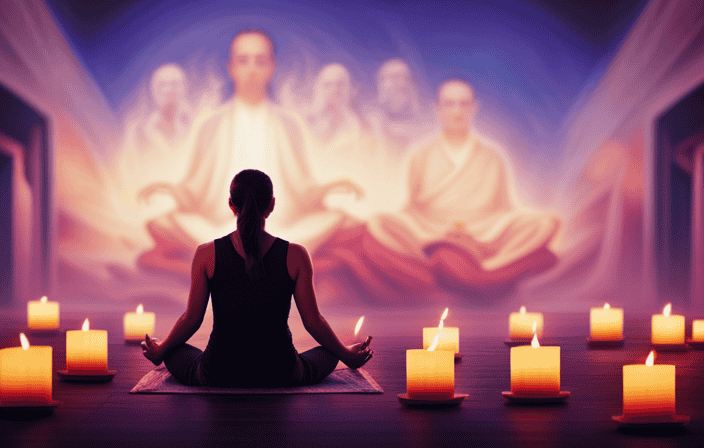
Enter the world of tantric meditation, where the enigmas of the mind and body blend together in a graceful dance.
Like a hidden treasure waiting to be discovered, this ancient practice unveils a path to deep connection and profound transformation.
Through sacred positions and nurturing practices, tantric meditation invites us to explore the depths of our being, embracing our desires and harnessing our sexual energy for spiritual awakening.
Join me on this journey as we unravel the secrets and unlock the power of tantric meditation.
Key Takeaways
- Tantric meditation integrates spirituality, mindfulness, and sexuality.
- It recognizes sexual energy as sacred and transformative.
- Trust, openness, and vulnerability are essential for tantric meditation.
- The practice cultivates deep connection, intimacy, and personal growth.
What is it?
I can explain what tantric meditation is in the context of the pre-existing knowledge.
Tantric meditation is a practice that integrates spirituality, mindfulness, and sexuality, taking a holistic approach to the human experience. It embraces our physical desires and sensory experiences, recognizing sexual energy as sacred and transformative.
What sets tantric meditation apart is its emphasis on connection and intimacy with oneself and others. It goes beyond traditional meditation practices by incorporating the exploration of our deepest desires and the cultivation of a deep sense of connection and trust.
Tantric meditation can be practiced individually or with a partner, and it is not limited to any specific religious tradition. It is a practice that invites us to approach our spirituality and sexuality with openness, respect, and a willingness to explore and grow.
Practices and Positions
A variety of positions and practices can be utilized in tantric meditation to foster trust, openness, and vulnerability while deepening connections with oneself and others. These practices are designed to create a safe and supportive environment for spiritual evolution.
Here are three key positions and practices commonly used in tantric meditation:
-
Nurturing Meditation: Sit facing your partner, place your hands on each other’s hearts, make eye contact, and synchronize your breath. This practice promotes a sense of deep connection and intimacy.
-
Yab-Yum or Lotus: In this position, one partner sits in the lap of the other, maintaining eye contact. This symbolizes the union of energies and fosters a sense of unity and harmony.
-
Hands On Hearts: Sit facing your partner, place your hands on each other’s hearts, make eye contact, and focus on the energy flowing between you. This practice cultivates trust, openness, and vulnerability.
These positions and practices can be adapted based on comfort and preferences, allowing individuals to explore and deepen their spiritual connection in a way that feels authentic to them.
Unique Characteristics
Integrating spirituality, mindfulness, and sexuality, tantric meditation offers a holistic approach to human experience. Unlike other forms of meditation, tantric meditation embraces our physical desires and sensory experiences, recognizing sexual energy as sacred and transformative. It emphasizes the importance of connection and intimacy with oneself and others, allowing us to explore the depths of our being.
By integrating our spirituality, mindfulness, and sexuality, we can tap into a profound sense of self-discovery and personal growth. Tantric meditation promotes mindfulness and connection with the divine, allowing us to harness our sexual energy for spiritual transformation. This unique practice fosters a holistic approach to spiritual awakening, inviting us to explore the depths of our desires and emotions, and ultimately leading us to a more profound sense of connection and fulfillment.
FAQs and General Information
One important aspect of tantric meditation is that it can be practiced individually, not just by couples. This means that anyone, regardless of their relationship status, can experience the transformative power of tantric meditation.
Here are some frequently asked questions and general information about tantric meditation:
-
Is tantric meditation only about sexuality?
- No, tantric meditation integrates spirituality, mindfulness, and sexuality. It takes a holistic approach to the human experience, recognizing the sacredness and transformative nature of sexual energy.
-
Is tantric meditation limited to specific religions?
- No, tantric meditation can be found in various traditions and is not exclusive to Hinduism and Buddhism. It is a practice that can be adapted and practiced by anyone with respect and openness.
-
Can tantric meditation be combined with other spiritual practices?
- Yes, tantric meditation can be combined with other forms of meditation or spiritual practices. It is a versatile practice that can enhance and complement other spiritual journeys.
-
Do I need to have a partner to practice tantric meditation?
- No, tantric meditation can be practiced individually. While some positions and practices involve a partner, there are also solo practices that allow for deepening connection and intimacy with oneself.
Importance of Trust
Trust is an essential component of tantric practice as it allows for deepening connection and exploration. When engaging in tantric meditation, trust creates a safe and supportive environment for spiritual evolution. It is the foundation upon which profound intimacy and vulnerability can be built. Trust allows us to let go of inhibitions, fears, and doubts, enabling us to fully surrender to the experience.
It is through trust that we can open ourselves up to the transformative power of tantric meditation. By trusting ourselves and our partners, we create a space where authenticity and acceptance thrive. Trust fosters a sense of security, allowing us to explore our desires and boundaries without judgment.
It is through trust that we can truly connect with ourselves, others, and the divine, unlocking the mysteries and experiencing the profound benefits of tantric meditation.
Benefits and Goals
Enhancing self-discovery and personal growth through tantric practices and meditation is a profound goal. By embracing the holistic approach of tantric meditation, we can unlock a wealth of benefits and achieve our highest potential.
Here are three key ways in which tantric meditation can enrich our lives:
-
Deep Connection and Intimacy: Through tantric practices, we can cultivate a profound sense of connection and intimacy with ourselves and others. By embracing our physical desires and sensory experiences, we can create a space for deepening our relationships and fostering genuine connections.
-
Spiritual Transformation: Tantric meditation harnesses the power of sexual energy to facilitate spiritual transformation. By recognizing sexual energy as sacred and transformative, we can tap into its immense potential for personal growth and spiritual evolution.
-
Mindfulness and Divine Connection: Tantric meditation promotes mindfulness and enhances our connection with the divine. By integrating spirituality and mindfulness into our practice, we can cultivate a deeper awareness of ourselves and our connection to the world around us.
In conclusion, tantric meditation offers a unique pathway to self-discovery, personal growth, and spiritual awakening. By embracing its teachings and practices, we can embark on a transformative journey towards greater fulfillment and enlightenment.
Integration with Other Practices
Now that we have explored the benefits and goals of tantric meditation, let’s delve into the fascinating way in which it can be integrated with other practices. Tantric meditation is not limited to being practiced in isolation, but can be combined with various spiritual and meditative techniques to deepen and enhance our experience. By integrating tantric meditation with other practices, we can tap into different aspects of our being and open ourselves up to new dimensions of growth and transformation.
To illustrate the possibilities, let’s consider a 3-column table that showcases some examples of how tantric meditation can be integrated with other practices:
| Practice | Description | Benefits |
|---|---|---|
| Yoga | Combining tantric meditation with yoga asanas can enhance body awareness and energy flow, promoting physical and spiritual health. | Increased flexibility, improved focus, and heightened spiritual connection. |
| Breathwork | Incorporating breathwork techniques with tantric meditation can deepen the connection to our life force energy, intensify sensations, and expand consciousness. | Enhanced breath control, increased energy flow, and expanded states of awareness. |
| Sound Healing | Integrating sound healing practices, such as chanting or listening to sacred music, with tantric meditation can amplify the vibrational energy and facilitate deeper states of relaxation and spiritual connection. | Heightened sense of peace, harmonized energy centers, and enhanced spiritual experiences. |
By integrating tantric meditation with other practices, we can explore new dimensions of our being, deepen our spiritual connection, and expand our personal growth and transformation. It is a beautiful way to create a holistic approach to our spiritual awakening.
Creating a Safe Environment
To ensure a safe environment for practicing tantric meditation, it is important to establish clear boundaries and communicate openly with oneself and others. This means being aware of personal limits and expressing them honestly.
It also involves actively listening to the needs and desires of your partner or partners, and respecting their boundaries as well. Creating a safe space requires trust, openness, and vulnerability, where everyone feels comfortable and supported.
It is essential to have open and honest conversations about consent, desires, and intentions before engaging in any tantric practices. This allows for a deeper level of connection and understanding, fostering a sense of safety and security.
By creating this safe environment, we can fully explore the transformative power of tantric meditation and experience profound spiritual growth.
Frequently Asked Questions
How can tantric meditation be integrated with other forms of meditation or spiritual practices?
To integrate tantric meditation with other forms of meditation or spiritual practices, one can incorporate tantric principles like mindfulness, connection, and embracing physical desires into their existing practice. This can deepen the experience and bring a more holistic approach to spiritual growth.
Can tantric meditation be practiced by individuals who are not in a romantic relationship?
Absolutely! Tantric meditation can be practiced by individuals who are not in a romantic relationship. It is a beautiful path of self-discovery, personal growth, and spiritual transformation that can be embraced by anyone with openness and respect.
Is tantric meditation limited to Hinduism and Buddhism, or is it found in other traditions as well?
Tantric meditation is not limited to Hinduism and Buddhism, as it can be found in various traditions. It is a practice that can be embraced by anyone with respect and openness, regardless of their religious or spiritual background.
What are some specific techniques or exercises that can be practiced during tantric meditation?
During tantric meditation, specific techniques and exercises can be practiced to deepen connection and intimacy. These include nurturing meditation, yab-yum or lotus position, and hands on hearts. These practices foster trust, openness, and vulnerability.
How does tantric meditation specifically harness and transform sexual energy for spiritual purposes?
Tantric meditation harnesses and transforms sexual energy for spiritual purposes by recognizing it as sacred and transformative. Through practices such as breathwork, visualization, and mindfulness, sexual energy is channeled and directed towards spiritual growth, self-discovery, and deepening connection with oneself and others.
Meet Nadi, the soulful writer and explorer of inner realms who graces OurMindAndBody.com with her profound insights and heartfelt wisdom. With a profound passion for mindfulness, meditation, and spiritual growth, Nadi weaves words that touch the hearts and minds of readers, leaving a lasting impact on their well-being journey.
Rooted in a background of philosophy and psychology, Nadi’s curiosity about the human mind and the mysteries of the soul led her on a transformative path of self-discovery. Drawn to the transformative power of mindfulness and meditation, she embarked on a quest to understand the intricacies of these practices, not only for her own growth but also to inspire others to embark on their own inner journeys.
Meditation
Unlocking The Power Of Flower Energy In Meditation
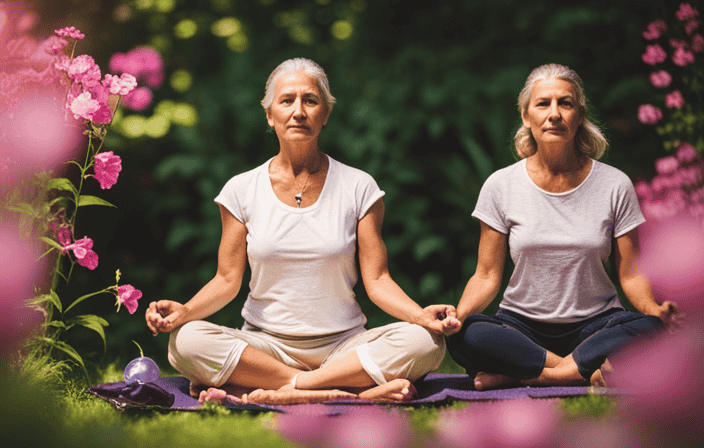
Similar to a fragile flower blossoming under the gentle caress of sunlight, flower meditation enables us to tap into the unseen potential of nature’s energy that lies within us.
In this article, we will explore the transformative benefits of flower meditation, from reducing stress and anxiety to fostering a deep connection with the natural world.
Through this practice, we can align our mind, body, and spirit, bringing peace and tranquility into our lives.
Join me on this spiritual journey as we discover the profound effects of harnessing the power of flower energy in meditation.
Key Takeaways
- Flower meditation heightens self-awareness.
- Engaging with flowers reduces stress, anxiety, and tension.
- Flower meditation fosters a connection with nature.
- Flower energy aligns the mind, body, and spirit.
What is it?
Flower meditation is a practice that I can incorporate into my daily life to unlock the power of flower energy and enhance my overall well-being.
It is a beautiful and calming practice that allows me to connect with nature on a deeper level. By focusing my attention on the intricate details of a flower, I become more present and mindful.
This practice heightens my self-awareness and brings clarity to my thoughts and emotions. The soothing effect of flowers helps me to reduce stress, anxiety, and tension. As I engage with the energy of flowers, I feel a sense of peace and tranquility wash over me.
Flower meditation aligns my mind, body, and spirit, creating a harmonious balance within me. It is a practice that nourishes and revitalizes my being, leaving me feeling more connected and alive.
Benefits of Flower Meditation
Engaging in this practice heightens my self-awareness and promotes living with intention. Flower meditation allows me to focus on the present moment, cultivating mindfulness and bringing clarity to my conscious choices. The soothing effect of flowers on my mind and body reduces stress, anxiety, and tension, promoting relaxation and a sense of peace.
Through flower meditation, I foster a deep connection with nature, immersing myself in the beauty of flowers and developing an appreciation for the natural world. This practice also encourages environmental consciousness, reminding me of my relationship with the Earth and the importance of mindfulness towards it.
Furthermore, flower energy aligns my mind, body, and spirit, creating balance and enhancing my holistic well-being. It merges with my personal energy, revitalizing me and improving my overall vitality.
Incorporating flower meditation into my daily life is simple. I display fresh flowers as a visual reminder of the present moment, take mindful walks in nature to observe flowers, create flower arrangements, and practice gratitude for the beauty of flowers and nature.
Flower meditation truly unlocks the power of flower energy, allowing me to experience a deeper connection with myself, nature, and the universe.
Connection with Nature
Immersing in the beauty of nature through this practice fosters a deep connection with the environment and cultivates an appreciation for its wonders.
Flower meditation encourages us to slow down and truly observe the intricate details and vibrant colors of the flowers around us.
As we take mindful walks in nature and observe the flowers, we become more aware of the interconnectedness of all living beings and the importance of preserving the natural world.
This awareness promotes environmental consciousness and a sense of responsibility towards the Earth.
The beauty and tranquility of flowers remind us to be grateful for the gifts of nature and to treat the Earth with respect and care.
Through flower meditation, we can deepen our connection with nature and find solace and inspiration in its ever-changing beauty.
Mind-Body-Spirit Connection
Through this practice, I feel a deep sense of alignment between my mind, body, and spirit.
As I engage in flower meditation, I am reminded of the interconnectedness of all aspects of my being.
The energy of the flowers merges with my own, creating a harmonious balance within me.
I become more aware of any imbalances or areas that need attention, allowing me to address them with compassion and kindness.
This connection between my mind, body, and spirit enhances my overall well-being and vitality.
I am able to tap into a profound sense of inner peace and clarity.
The flower energy acts as a gentle guide, leading me towards a higher level of consciousness and spiritual growth.
It is truly a transformative experience that nourishes my entire being.
Incorporating into Daily Life
Incorporating flower meditation into my daily life allows me to create a deeper connection with nature and cultivate a sense of mindfulness. Displaying fresh flowers in my home serves as a visual reminder to stay present and appreciate the beauty of the present moment.
Taking mindful walks in nature and observing the intricate details of flowers helps me to immerse myself in the natural world and develop a sense of gratitude for its wonders. I also enjoy creating flower arrangements and participating in floral crafts, which not only brings me joy but also allows me to express my creativity.
By practicing gratitude for the beauty of flowers and nature, I feel a profound sense of peace and tranquility. Flower meditation has truly become an integral part of my daily routine, bringing me closer to nature and enhancing my overall well-being.
Types of Flower Meditation
By exploring different techniques such as rose meditation and golden flower meditation, I have discovered new ways to deepen my spiritual practice and expand my consciousness.
Rose meditation has been a profound experience for me, as it allows me to tap into self-love, compassion, and emotional healing. Focusing on the delicate petals of a rose brings a sense of peace and acceptance into my being. It reminds me to be gentle with myself and others, fostering a deep connection with the world around me.
On the other hand, golden flower meditation has opened up a whole new realm of spiritual insights. Visualizing an imaginary golden flower within my body has helped me access higher levels of consciousness and awareness. It is a powerful practice that brings clarity and enlightenment to my journey.
Exploring these different types of flower meditation has truly transformed my spiritual path, allowing me to unlock the immense power of flower energy in my meditation practice.
Exploring different types of flower meditation has expanded my spiritual practice and deepened my connection to the world around me. Each type of flower meditation has its own unique energy and intention, allowing me to explore different aspects of myself and the universe.
-
Rose meditation: By focusing on a rose, I am reminded of the power of self-love and compassion. It brings forth emotions of tenderness and nurturance, allowing me to heal and grow emotionally.
-
Golden flower meditation: This practice takes me on a journey within, as I visualize an imaginary golden flower. It helps me tap into higher levels of consciousness and spiritual insights, guiding me towards profound awareness and enlightenment.
-
Nature immersion meditation: By simply observing flowers in nature, I am filled with awe and wonder. It reminds me of the interconnectedness of all living beings and the beauty that surrounds us. It evokes a sense of gratitude and reverence for the natural world.
Through these different types of flower meditation, I am able to unlock the power of flower energy and experience a deeper sense of peace, harmony, and spiritual growth.
Engaging in different types of flower meditation has deepened my spiritual practice and allowed me to connect more profoundly with myself and the world around me.
The beauty and energy of flowers have a transformative effect on my meditation experience. When I choose a flower as my focal point, I am able to observe its intricate details and immerse myself in its essence.
Whether it’s the self-love and compassion of rose meditation or the awakening of spiritual insights through golden flower meditation, each practice brings a sense of peace and tranquility.
As I merge my personal energy with the flower’s energy, I feel a harmonious balance within myself.
Flower meditation has become an integral part of my daily life, reminding me to be present, grateful, and connected to the natural world.
Frequently Asked Questions
How can I choose the right flower for my meditation practice?
To choose the right flower for your meditation practice, trust your intuition. Allow yourself to be drawn to a flower that resonates with you, whether it’s for its color, scent, or symbolism. Let the flower guide and support your meditation journey.
Can flower meditation be done indoors, or does it have to be in nature?
Yes, flower meditation can be done indoors. Although being in nature enhances the experience, the soothing energy of flowers can still be harnessed indoors. Simply bring fresh flowers into your meditation space and let their beauty and tranquility guide you.
Are there any specific techniques or methods to enhance the effects of flower meditation?
To enhance the effects of flower meditation, I suggest deepening your focus on the chosen flower, allowing its energy to flow through you. Visualize the flower’s qualities and intentions, and maintain a state of gratitude and receptivity throughout the practice.
Can flower meditation help with specific physical or mental health issues?
Flower meditation has the potential to assist with various physical and mental health issues. By promoting relaxation, reducing stress, and increasing self-awareness, it can contribute to overall well-being and healing.
Are there any precautions or considerations to keep in mind when practicing flower meditation?
When practicing flower meditation, it’s important to approach it with an open mind and respect for nature. Take care to choose flowers that are safe for you and your environment, and ensure a peaceful and distraction-free space for your practice.
Meet Nadi, the soulful writer and explorer of inner realms who graces OurMindAndBody.com with her profound insights and heartfelt wisdom. With a profound passion for mindfulness, meditation, and spiritual growth, Nadi weaves words that touch the hearts and minds of readers, leaving a lasting impact on their well-being journey.
Rooted in a background of philosophy and psychology, Nadi’s curiosity about the human mind and the mysteries of the soul led her on a transformative path of self-discovery. Drawn to the transformative power of mindfulness and meditation, she embarked on a quest to understand the intricacies of these practices, not only for her own growth but also to inspire others to embark on their own inner journeys.
-

 Aura2 months ago
Aura2 months agoUnderstanding The Grey Aura: Balance, Neutrality, And Personal Growth
-

 Meditation2 months ago
Meditation2 months agoUnderstanding Spiritual Attacks: Types, Signs, And Protection
-
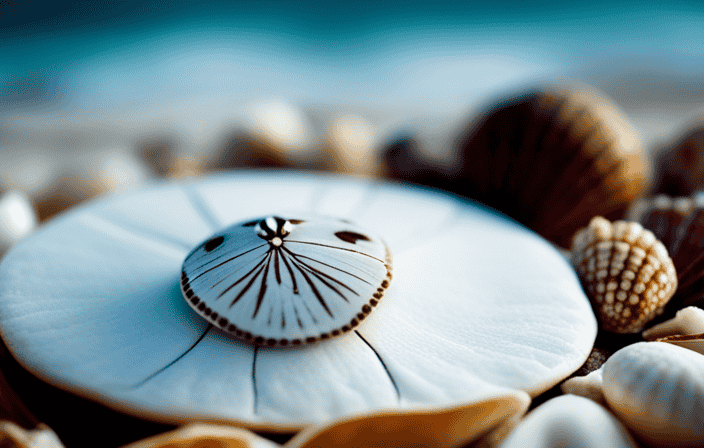
 Meditation2 months ago
Meditation2 months agoThe Symbolic Significance Of Sand Dollar: Spiritual Meanings And Cultural Connections
-

 Spirituality4 weeks ago
Spirituality4 weeks agoThe Power Of Spiritual Connection: Definition, Importance, And Ways To Achieve
-

 Inspiration1 month ago
Inspiration1 month agoThe Power Of Spiritual Impartation: Empowering Believers And Cultivating Growth
-

 Inspiration21 hours ago
Inspiration21 hours agoThe Role And Qualities Of A Spiritual Advisor: A Guide On The Path
-

 Spirituality3 weeks ago
Spirituality3 weeks agoThe Power Of Spiritual Cleansing: History, Benefits, Techniques, And Personal Experiences
-
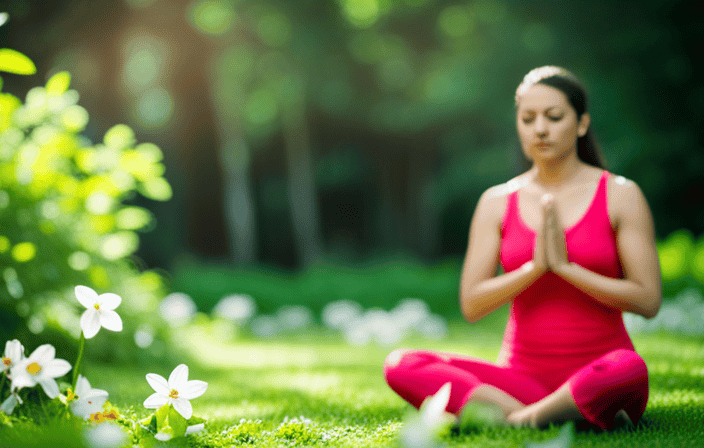
 Spirituality4 weeks ago
Spirituality4 weeks agoConnecting Spirituality And Daily Life: Embracing Universal Values





